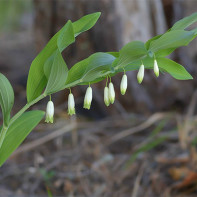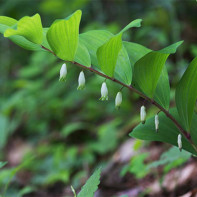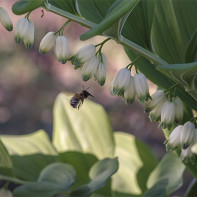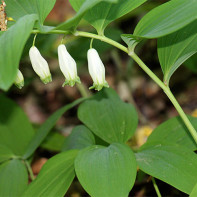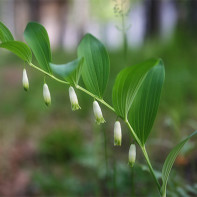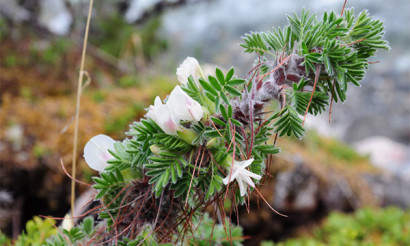Cupena: therapeutic properties and contraindications
Coupea is a medicinal perennial herb, widespread in Siberia and the CIS countries. Many people know coupe under other, widespread popular names - wolf's apples, crow's feet, straw seal and deaf grass. Many varieties of this plant have not only decorative but also medicinal value. In ancient times, it was especially popular among folk healers. Thanks to it cured many common diseases such as bronchitis, rheumatism, hemorrhoids and other ailments.
- Chemical composition
- What it looks like and where it grows
- Types of
- Collection and storage
- Medicinal properties of cupua
- Expectorant effect
- Analgesic effect
- A remedy against swelling
- Restorative effect
- Blood-stopping effect
- Coupea in folk medicine
- Infusion
- Tincture
- Decoction
- Cosmetic application
- Against red spots from measles, smallpox and acne
- To lighten freckles and age spots
- Against pigmentation and redness
- Domestic Use of Coulea
- How to grow Money-planting
- Planting
- Care
- Fertilizer and nutrition
- Features
- Contraindications to use
Chemical Composition
Each part of the medicinal cupuna is rich in useful substances for the human body:
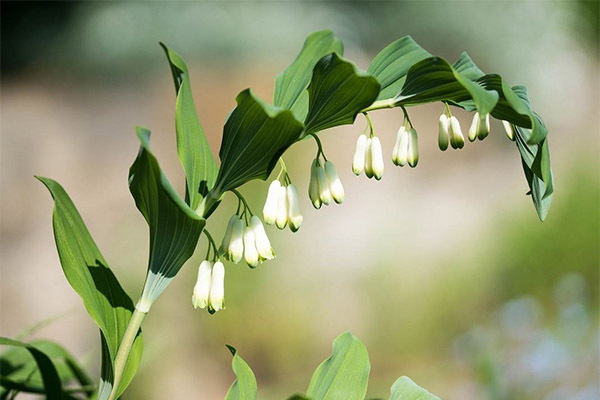
- The rhizome has starch, mucilaginous substances, alkaloids, fructose and arabinose.
- The leaves contain vitamin C and flavonoids.
- Glycosides accumulate in the berries.
All these components are the basis of the unique chemical composition of the popular medicinal plant. Flavonoids strengthen capillaries and promote the removal of radioactive substances from the body. Glycosides and their compounds have a beneficial effect on the circulatory system and support cardiac activity. Vitamin C strengthens the immune system and participates in the healing process. Alkaloids are referred to as antispasmodics. A choleretic and analgesic effect is also noted.
When recuperating with kupena, it is important to be aware of the dosage of the drug. A large amount of this medicinal plant is poisonous to humans and can lead to irreversible consequences.
How it looks and where it grows
In total, there are more than 60 species of cupuna. In our area, fragrant, pink and multiflowered coulombs are common.
The grass has a branched broad rhizome and elastic, faceted stems that reach 2 meters in height. The leaves point in one direction, are oblong in shape, green and blue-green in color. Flowers of white and light purple hue are fragranceless, the shape of the bellflower reminiscent of the lily of the valley known to all. In some ornamental species there are bright orange and red shades of flowers. The fruit is a dark blue-black spherical poisonous berry. It is because of the appearance of the berries that the plant is popularly called "crow's eye".
Cupena blooms from mid-April to June, depending on the species. Berries ripen in August.
The plant is found throughout the northern hemisphere. Coupea grows in meadows and slopes, and also blends harmoniously into mountain and forest landscapes. The unpretentious grass gets along with various plants and conifers. Cupena of any kind is resistant to various unfavorable weather conditions.
Types
Cupena is known to many people not only as a medicinal plant. Because of its rich species diversity, it is common throughout the Northern Hemisphere as an unpretentious ornamental plant.
- Cupena broadleaf. A medicinal species of the plant. Distinctive feature is the thin white outline along the edge of the rich green leaf. The grass reaches half a meter in height during the flowering period. The stem has an arched shape. The flowers of the broadleaf cupuna are light-colored, growing in pairs. After flowering, the plant is covered with berries of a rich dark blue color.
- Coupea narrow-leaved. The grass reaches a height of up to 1 m. The stems are round with a pubescent top. The pointed leaves are deep green and grow evenly down the stem. The color of the buds is predominantly light. After the flowering period, berries of a deep dark blue hue and regular round shape are set. The variety is resistant to drought and other adverse conditions. Dense soils and a shady side of the plot are necessary for active growth.
- Siberian Coupe. A sturdy plant with an impressive root and a strong and dense stem. It can reach a height of up to 70 cm. Leaves are predominantly dark green and elongated in shape. The flowers are of light shades. This species is distinguished by the uncharacteristic purple-red color of berries.
- Caucasian Couleena. Strong faceted stem of the plant does not exceed the height of 40 cm. The oval-shaped leaves are large compared to other species. Flowering is early - from mid April to early May. Flowers are mostly light. The berries are a rich dark blue color and have a regular rounded shape.
- Bare Coupeena. A species with a sprawling root system, a dense sturdy stem reaching about 1 m in height. The lower part of the stem is characterized by a reddish color. Leaves of elongated shape are evenly arranged along the stem.
- Multiflowered cupena. A shade-loving medicinal species that grows on slopes in the mountains. The plant is not more than 1 m tall. There are pointed leaves along the stem. The upper part of the leaf is a deep green, the lower part a gray-green shade. Flowering is early - until the beginning of May. Flowers are light. A distinctive feature of this variety is the pleasant velvety surface of the petals.
- Squat Couleena. A plant with naked upright elastic stems, reaching a height of 40 cm. Leaves have an oval elongated shape and a bright rich green hue. It will flower for an extended two weeks. The buds grow singly. The flowers are light in color. The berries are rounded in shape and have a rich bright blue color.
- Coupea fragrant. The most popular apothecary variety. The stems of the herb do not exceed a height of 60 cm. Leaves of a fresh green hue have a white border. The buds are white. The berries are a rich blue-black color.
- Coupea whorls. A weed with a slender graceful stem about 50 cm tall. Leaves are located at the base of the stem and at the top. The light green leaves are oblong in shape and have a pointed edge. The flowers are light colored. The berries are a rich dark blue color.
- Coupea pink. Siberian species. The stem is straight with reddish blotches. Leaves are arranged in groups along the stem. Buds are light with a pink tint. Fruits in the form of berries of uncharacteristic rich red color.
Harvesting and storage
The leaves and flowers of Cougar are collected during the flowering period. It is recommended to cut off no more than one third of all leaves to preserve the plant. The rhizome is dug at the end of the season - from mid-October to the first days of November.
Like all other useful plants, coupea is harvested in clean places away from the city and highways. The ideal place of collection is the nearest forest.
Harvested flowers and leaves are dried naturally in a ventilated clean room. Flowers and leaves are laid out in a single layer on a flat surface and left to dry completely. Raw material deprived of moisture loses its original intense color and flavor.
The excavated roots are thoroughly washed from the soil, remove the spoiled and dead parts of the root system. Dry in a clean room with a high temperature regime or in a special dryer.
The ripe berries are collected in warm and dry weather to avoid spoiling the raw material. Berries are scattered loosely in a warm and constantly ventilated room and left to dry.
After complete drying, stored in cotton or linen bags in a dry and dark place, use within 2 years.
Medicinal properties of Couleena
Cupena is widely used in medicine, thanks to its valuable properties:
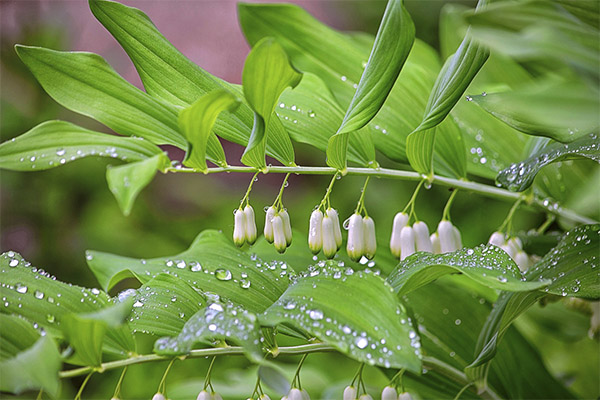
Expectorant effect.
Cupena will ease the course of colds. The plant liquefies sputum and helps to relieve inflammation.
Analgesic effect
Tincture alleviates the pain of rheumatism. A decoction for migraines is also popularly known. It has no effect on the source of pain, but only relieves a severe symptom.
A remedy for swelling
Swelling caused by dropsy and diabetes, rapidly go away if you add to the treatment recommended by the doctor folk remedies with Kupena.
Restorative effect
The medicinal plant is also widely used in cosmetology to treat problem skin and lighten unwanted pigmentation. The brightening effect has a short-term effect in the fight against freckles and age spots. Remedies with Kupena help get rid of post-acne spots, which can remain on the skin for years after acne treatment. To avoid burns and allergic reactions when using kupena, it is important to follow expert recommendations.
Blood-relieving property
The starchy component of the plant is applicable to the treatment of diseases of the gastrointestinal tract for ulcers. The enveloping composition prevents bleeding during the passage of food. The anti-inflammatory action contributes to a faster and easier course of the disease.
Despite the significant number of useful components in the composition, the plant has no widespread use in scientific medicine. This is due to a pronounced toxic effect and a mild therapeutic effect, compared to other plant sources of healing substances.
Coupea in folk medicine
All parts of Cupena are widely used for the treatment by folk methods. From the rhizome, stems, leaves, flowers and even poisonous berries are prepared effective remedies for a variety of common ailments.
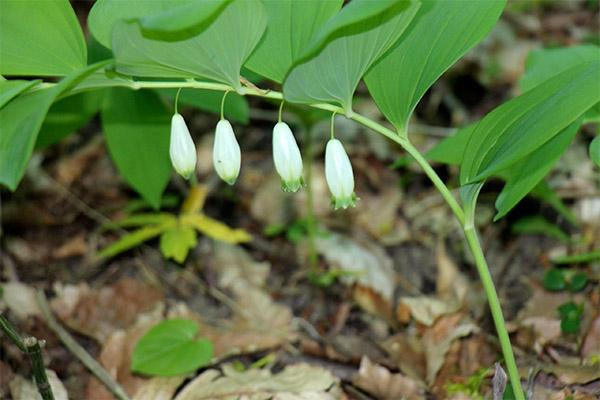
Infusion .
Infusions are prepared from the flexible parts of the plant: stems, flowers and leaves.
Infusion of dried leaves
Used to relieve the course of cholelithiasis, arthritis. Pain-relieving and anti-inflammatory properties help the body to overcome these diseases. Also used as a diuretic and antipyretic.
1 tbsp. leaves pour a glass of boiling water, soak on low heat for 15 minutes. The resulting remedy infused for an hour. Strain the infusion ready for use. Take 1 tbsp. twice a day for 30 minutes before a meal.
Tincture .
Alcoholic tinctures of medicinal herbs are suitable for long-term storage - from several months to 3 years. Such a therapeutic remedy is better to keep in a dark cool place to preserve the healing properties for a long time.
The use of tincture is so wide that there are different ways of preparation, dosage and frequency of reception, depending on the specific disease.
Alcohol tincture has 2 common methods of preparation:
- 10 tbsp of dry crushed rhizomes pour 1 liter of vodka and insist 1 month.
- 50 g of crushed roots poured 0.5 l 70% alcohol, and kept in a dark cool place for 20 days.
Intake and dosage of the tincture depends on the severity of a particular disease, so it is necessary to consult a doctor.
Decoction
Decoctions are most often prepared from the hard part of the plant - the rhizome. The shelf life of any decoction - no more than one day, so for proper treatment it is necessary to prepare a fresh medicinal remedy every day.
Decoction from the shoots
A favorable effect of decoction from the shoots of Cupena on the mucosa of the gastrointestinal tract in gastritis has been noted. The enveloping properties of the starch help to restore the mucosa. The anti-inflammatory effect will help speed up recovery.
Several dried shoots pour 2 cups of boiling water and infused for 30-40 minutes. The strained decoction is ready for use. 1 cup of therapeutic composition of Cupua drink 20 minutes before a meal. The maximum daily dosage is 3 cups of therapeutic solution.
Decoction of fresh rhizomes.
Washing and compresses with the decoction relieve swelling of the affected area of the skin, promote healing of bruises, abrasions, pustules. Antibacterial properties prevent possible complications due to the entry of infection. Decoction is also used externally to relieve the course of rheumatism, chronic back pain, gout and hemorrhoids.
1 tbsp fresh roots infused 0.5 l boiling water, after 5 minutes put on the fire, bring to a boil and remove from the heat. The broth insist 2-3 hours, pre-wrapped container with a healing agent in a towel. For oral use is sufficient 1-2 tbsp. for 30 minutes before a meal.
Decoction of dried rhizomes.
Used as a compress to relieve joint pain, is also taken internally in the treatment of bronchitis and pneumonia. Decoction removes phlegm and promotes speedy recovery even with a severe cough.
1 tsp. Pour 1 cup boiling water over dry crushed roots, insist on a water bath under a lid for 30 minutes. Decoction should cool naturally to a comfortable temperature. Strain the remedy is ready for use. Is taken internally 1 tbsp. 3 times a day for 30 minutes before a meal.
Milk broth from the rhizomes.
Zabaikalsky medicinal decoction with milk is used internally for hernias and ulcers. The enveloping effect alleviates the course of ulcers. Anti-inflammatory properties contribute to a quick recovery. Analgesic effect will help to relieve painful sensations.
The remedy is prepared in a clay pot. 1 L of milk is poured into the pot, add 20 g of dried rhizomes. Decoction is steamed over low heat until 2/3 of the entire volume has evaporated. The resulting cure is strained and taken 1 tbsp. 3 times a day.
Decoction of the crushed root.
Used to relieve coughs from colds. Decoction removes phlegm and speeds up the healing process. It also removes worms and other parasites from the body.
To prepare you will need 1 cup of water and 1 tbsp. crushed rhizome. The decoction is prepared on a water bath for 40 minutes. Use 1 tbsp. 3 times a day.
Decoction made from the root of Cougar.
Special anti-inflammatory composition for the treatment of wounds, cuts, burns and other skin injuries.
To 0.5 l of water, add 50 g of the root of cupua, boiled for 10 minutes over low heat. The decoction should cool naturally and infuse for several hours. To the solution add 2 cups of clean water at room temperature. Soak a bandage in the decoction and apply it to the affected area of the skin for 10 minutes. After the procedure, the decoction is washed off with cool water.
A large variety of useful trace elements endows all parts of Cupuna with therapeutic properties that can cope with many common diseases. However, use for medicinal purposes requires extreme caution. Excessive dosage can adversely affect the human condition, lead to severe poisoning, so before using medicines based on cupna, it is necessary to consult with an appropriate specialist or attending physician.
Applications in cosmetology
Medicinal cupuna, thanks to its diverse useful composition, appears among the ingredients of many cosmetics: creams, masks, lotions. There is also an essential oil of cupua, which is effective in the fight against freckles and age spots. Decoction cleanses problem skin with pronounced redness, rashes and inflammatory elements.

Against red spots from measles, smallpox and acne
1 tbsp. of dry crushed leaves of cupua pour 1 cup of cold water, bring to a boil. Keep the solution on low heat under a lid for 15 minutes. The decoction is cooled at room temperature and filtered. This product is used as a lotion after cleansing the face of other impurities and removing makeup.
To lighten freckles and age spots
Fresh rhizomes of Cupena are washed from the ground with cool running water, peeled and crushed to obtain a few drops of juice. The resulting liquid is diluted with a large amount of water. First, the remedy is tested on a clean patch of skin. If there are no adverse reactions, the diluted juice is dotted on freckles and pigmented spots for a few minutes. Then be sure to wash off the remedy. To achieve a clear effect, gradually increase the concentration of the active substance. It is important to act with great caution - the fresh juice of cougar can cause burns on the skin.
Against pigmentation and redness
Pharmacy essential oil of merena is also used to lighten freckles, age spots, redness after acne. The oil is diluted with water to avoid burns on the skin. The resulting solution is applied spot on the problem areas of the skin. After a few minutes the oil is washed off. To avoid negative consequences, it is recommended to consult a beautician or dermatologist before using.
The use of cupena in the home
Many livestock breeders use an alcoholic tincture of cupuna to treat cattle. A few drops of the remedy are added to the feed to increase the appetite of the animal and rid the cattle of parasites.
A variety of species of cuprene is used for landscaping in the shady part of the plot, where other plants are not comfortable. The unpretentious plant during the flowering period resembles lilies of the valley. After flowering, dark blue berries appear on the bushes, attracting attention. Bright greenery will be a great backdrop for flowers. Different height of varieties allows you to make original tiered compositions.
In the Caucasus, young shoots are added in small quantities to salads to add healthiness, spiciness, and piquancy to a dish.
In eastern countries, the verdure is available as part of popular spice blends.
How to grow coupea
Coupea will help the gardener to fill the empty space under trees, among shrubs even on the shady side of the land plot with bright greenery. A wide variety of species of this plant will amaze you with its diverse shape, height, type and color of leaves, color of fruits.
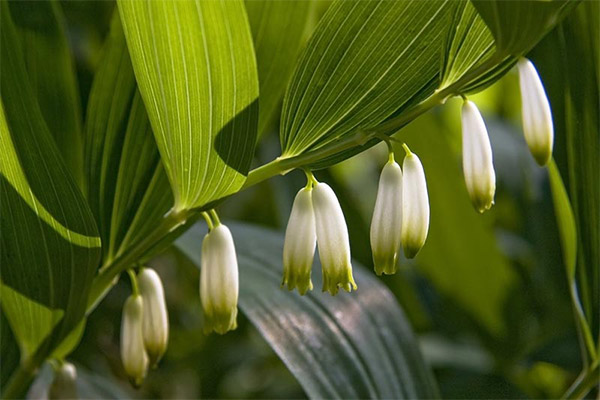
The largest cupuena can reach a height of up to 130 cm. Hardy varieties have a white border on the edges of the leaves. Decorative species will delight you with bright colors and unusual leaf shape. Dwarf plants with flowers and size similar to lilies of the valley.
The culture likes shade, restrains the growth of weeds, grows well in combination with conifers, ferns and various flowers.
Cupena is a real godsend for the lazy gardener. It is unpretentious in care, does not require shelter for the winter and grows without replanting for several years.
Planting
The plant is not particularly demanding to the quality of the soil, so planting can be carried out on any soil. While the cupola is growing, it needs regular watering without moisture stagnation. The ideal place for active growth and flowering of the cupuna is the shade of trees and tall shrubs. In such conditions, the plant proliferates widely, not allowing any weeds to survive.
Most often, coupea is propagated by dividing the root system. This method shows the highest percentage of germination. Multiplication by seeds is also common. Planting is carried out in early spring or at the end of the gardening season - autumn. When sowing, the distance should be at least 20 cm. In a small depression of soil, drainage is poured, put the root, cover with soil and water. The first 2 weeks of watering should be daily, except on rainy days.
Care
Cupena is a completely unpretentious plant. Watering is necessary only during periods of prolonged drought; at other times, natural soil moisture and rainfall are sufficient. The plant does not even need to be pampered by loosening the soil. The thin and fragile rhizome is close to the soil surface, so attempts to loosen the soil can harm the root system and end badly.
The first 2 years near the coupe need to thin out the weeds, then the plant grows, not giving them a chance to survive. Coupe is frost-resistant, so it does not require additional efforts and preparation for winter. The above-ground part completely dies off by the onset of cold weather, and in the spring you can already see the first sprouts. However, in a climate with a wide range of temperatures and harsh frosty winters, it is better to take care of the plant. You can cover the coupena with sawdust or branches of conifers.
Fertilizing and feeding
Like any other plants, the coupe takes a lot of nutrients from the soil, depleting it. Along with the entire plot of land, once a year the soil needs fertilizing. Every spring it is necessary to saturate the soil with organic fertilizers: manure or compost. Mineral fertilizers are also suitable for additional recharge. These procedures will be quite enough for the active growth and abundant flowering of cupuena.
A variety of forms and species of cupuena pleases fans of landscape design. High giant species can be used as a hedge. Medium-sized plants of different shapes will fit into any composition. Dwarf species will be a unique decoration of the garden. The mottled flowering vermilion is particularly striking.
Features
The roots, stems and leaves of the cupua contain poisonous substances, so you need to use thick gloves when transplanting the plant. The juice of the cupua can leave burns on the skin, so it is important to exercise caution when caring for it.
Contraindications for use
The use of cupuena as part of a medicinal remedy requires caution. Despite its many useful properties, the plant in all its parts also contains poisons that are dangerous to humans. It is important to observe the dosage, the time of exposure to the drug and the duration of application. Only a properly selected drug will bring benefits.
Therapeutic compositions with the use of cupuna are categorically contraindicated:
- children under 16 years of age;
- pregnant and nursing women;
- People prone to allergic reactions.
Before using folk remedies with Kupena, it is better to contact a specialist, who will help you choose the right recipe, the required dosage and duration of treatment. He will also advise on the possible negative consequences of improper preparation and application of therapeutic means.
«Important: All information on this site is provided solely for introductory purposes. Before applying any recommendations, consult a health care professional. specialist. Neither the editors nor the authors shall be liable for any possible harm caused by materials."

